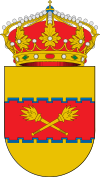Cetina, Aragon facts for kids
Quick facts for kids
Cetina, Aragon
|
|||
|---|---|---|---|
|
Municipality
|
|||
 |
|||
|
|||

Cetina in comarca de Calatayud
|
|||
| Country | |||
| Autonomous community | |||
| Province | Zaragoza | ||
| Comarca | Comunidad de Calatayud | ||
| Municipality | Contamina | ||
| Area | |||
| • Total | 78.76 km2 (30.41 sq mi) | ||
| Elevation | 666 m (2,185 ft) | ||
| Population
(2018)
|
|||
| • Total | 592 | ||
| • Density | 7.517/km2 (19.468/sq mi) | ||
| Time zone | UTC+1 (CET) | ||
| • Summer (DST) | UTC+2 (CEST) | ||
| Website | http://www.cetina.es/ | ||
| refs: | |||
Cetina is a municipality in the province of Zaragoza, Aragon. It is situated at an altitude of 666 metres (2,185 ft) in the south east of the province, in the Comunidad de Calatayud, some 176 kilometres (109 mi) north east of Madrid and 98 kilometres (61 mi) south west of Zaragoza. The population in 2011 was 687.
Cetina is also a Spanish surname (e.g. Gutierre de Cetina), originally used to refer to people who hailed from this town.
History
The origins of the settlement are unknown, but Ambrosio de Morales has identified Cetina as Certima or Celtima, a Celtiberian fort which was conquered by the Roman general Graco in 179 CE. The town lies on the Camino del Cid, the path taken by the medieval warrior, Rodrigo Díaz de Vivar, known as El Cid, according to the anonymous medieval poem, "El Cantar de Mio Cid", which follows the course of the river Jalón. The relevant lines state that "and they entered the plain of Torancio, and halted between Ariza and Cetina; great were the spoils which they collected as they went along." Cetina was granted its own fuero (law) by Guillén de Belles and Ramón Berenguer IV in the late 12th century.
In 1808, during the Peninsular War, the pueblo was pillaged by 18,000 French soldiers, commanded by Marshal Ney who occupied the area.
Buildings of interest
The castle stands on a small hill in the centre of the settlement. It is believed that it was captured by El Cid on his passage through the area. The castle chapel has some noted mudéjar decoration and was the location of the marriage of the 17th-century poet Francisco de Quevedo to Doña Esperanza de Mendoza in 1634. Nearby is the 15th-century parish church dedicated to San Juan Bautista (St John the Baptist).
Contradanza
The "contradanza" is a folk dance peculiar to Cetina, held on 19 May, the feast of San Juan Lorenzo, a fourteenth-century martyr who was born in Cetina. It is performed by nine young men, four wearing black jackets trimmed with white, four wearing white jackets trimmed with black, whilst the ninth, "the Devil", wears red. The ritual sacrifice of the devil is enacted and the dancers create shapes with their bodies, the whole accompanied by a constant monotonous tune. The dance was first mentioned in reports from 1751. In 2012, the government of Aragon declared the contradanza to be a special part of Aragon's cultural heritage.
Fiestas
- 17 January - San Antonio
- 19 May - San Juan Lorenzo and Santa Quiteria
- 22 May - pilgrimage to the hermitage of Santa Quiteria
- 19 October - Vergen de Atocha
See also
 In Spanish: Cetina (Zaragoza) para niños
In Spanish: Cetina (Zaragoza) para niños



